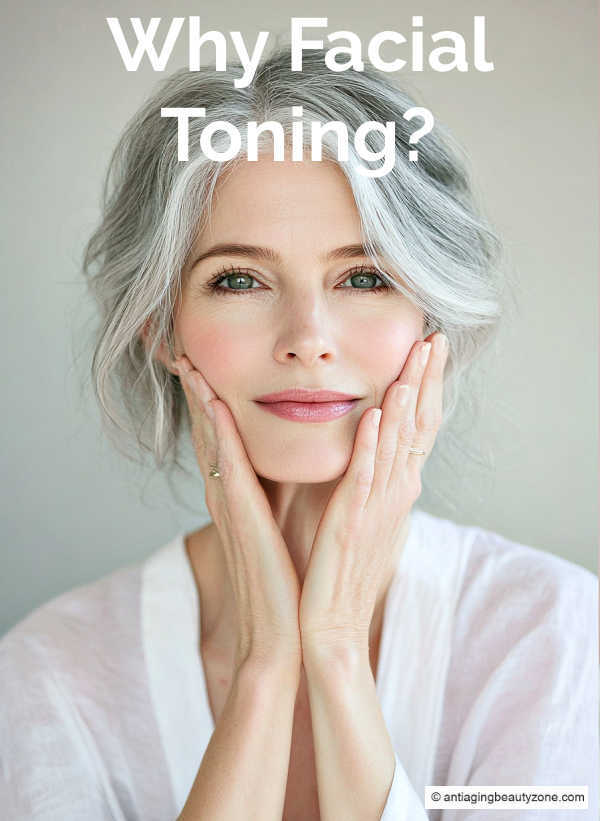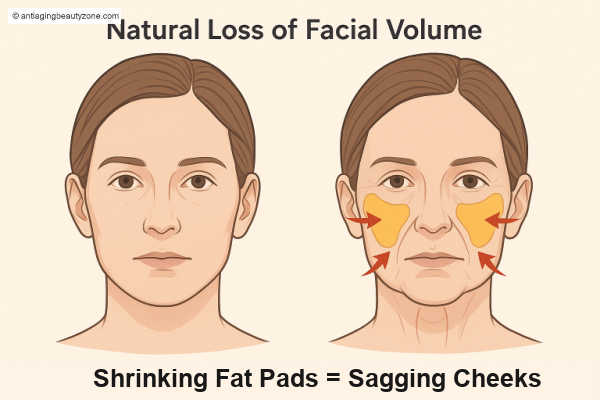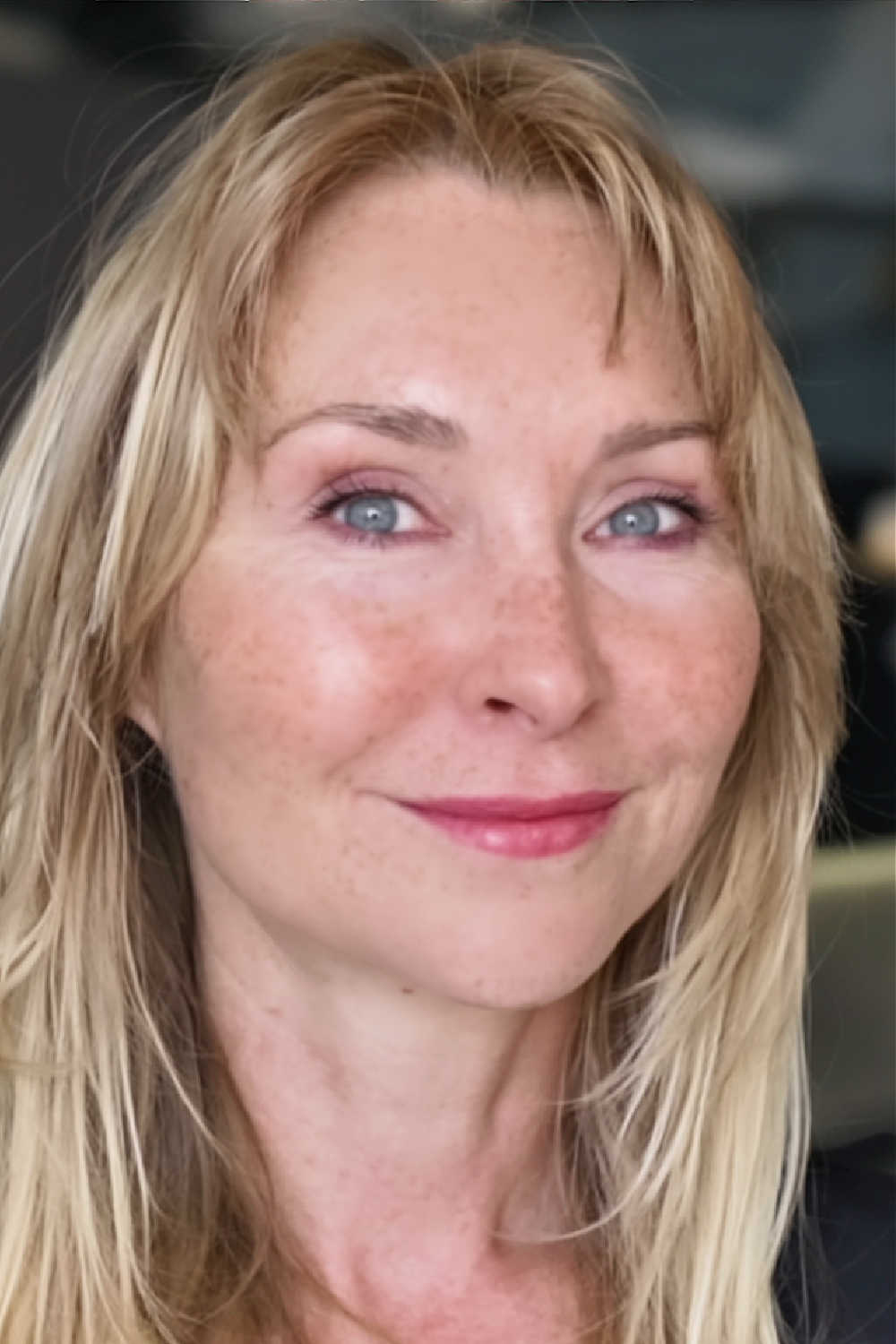
by: Linda Robison / Facial Fitness Specialist
You can’t “tighten” skin with exercise—but you can strengthen the muscles under it. That’s facial muscle toning. Stronger cheek, jaw, and neck muscles create a better foundation so the face can look a bit more lifted and defined.
Below, I explain how it works, what’s realistic, and one simple starter move (no full routine).

Can facial muscles be toned?
Yes. Like body muscles, facial muscles respond to repeated, controlled contractions with light resistance.
Toning can restore some structure underneath so features look slightly higher and cleaner—especially mid-face and along the jawline.
How facial muscle toning works (simple science)
 Why toning helps: as fat pads and facial bone volume decline with age, the skin has less scaffolding. Stronger muscles add a bit of underlying support.
Why toning helps: as fat pads and facial bone volume decline with age, the skin has less scaffolding. Stronger muscles add a bit of underlying support.Facial muscles sit just beneath the skin. With gentle, repeated contractions and enough recovery time, they can become a bit firmer—adding subtle support under areas that look softer with age.
This isn’t “skin tightening”; it’s about improving the foundation beneath the skin, so contours look a touch higher and cleaner.
- Muscle response: gentle resistance → contraction → recovery → gradual firmness/volume (hypertrophy).
- First changes you may notice: subtle cheek fullness, a tidier jawline, and a slightly more “awake” look.
- What it’s not: a skin-tightening treatment. Think “better support under the pillowcase,” not a new pillowcase.
Why toning helps: A fat pads and facial bone volume naturally decline with age, the skin has less “scaffolding.”
Stronger muscles can offer a bit more underlying support, which can make features look a touch lifted even though the skin itself isn’t being tightened.
Evidence (keep expectations realistic):
- Medical references on facial aging note reduced muscle tone as one contributor to a droopier look with age (Medline Plus, Aging changes in the face).
- A small study published in JAMA Dermatology reported that a consistent at-home facial exercise program was associated with improved mid-face fullness and slightly younger perceived age. The research is limited and results vary, so focus on safe, sustainable habits.
Toning muscles vs. tightening skin—what’s the difference?
Facial muscle toning: improves contour and lift potential by strengthening underlying muscles.
Skin-tightening/skincare: improves elasticity, texture, and glow (think retinol, peptides, sunscreen, devices).
Best results: pair a balanced exercise routine with simple skincare (cleanse, moisturize, sun protection).
Before & after—what’s realistic?
Consistent workouts over weeks to months can lead to small, visible changes. Below is my before-and-after, taken about 15 years apart with regular facial muscle toning (results vary).
 Me in my mid-50s before face exercises.
Me in my mid-50s before face exercises. Me over 66 yrs old doing facial exercises for over 15 years.
Me over 66 yrs old doing facial exercises for over 15 years.Exercises to tone facial muscles (safe starter moves)

These is a teaser so you can feel how toning works. For a structured, full-face sequence, see my Face Exercise Guide.
Starter exercise: Cheek Lifter
- Place index fingertips on the upper cheeks (beside the nose, under the eyes).
- Mouth closed so your cheek muscles do the work.
- Fingers are light anchors/weights—don’t press.
- Smile up & out with the cheeks to lift the anchors; stop when you feel your fingertips rise.
- Hold 2–3 sec, relax. 8–10 easy reps, about 3×/week.
Tip: Try this lying down—gravity gives light natural resistance, so you’ll feel the cheeks lift your fingertip “weights” without pressing.
How to tone your face without over doing it
More isn’t better here—recovery days matter. Keep the work gentle and consistent.
- Frequency: ~3 short sessions/week with rest days.
- Effort: gentle → focus on control and relaxation.
- Balance: work the whole face for even results.
- Add-ons: daily light massage supports circulation and lymphatic flow.
If you want area-specific help and video samples, try:
Facial Muscle Toning – FAQs
A: Yes, face exercises really do work! Look at my untouched before and after fitness results. But, just like any fitness program, you have to be consistent.
A: Many people notice small changes in 4–8 weeks. More visible definition often appears in 3–6 months with consistency.
A: Yes! If you do the right facial fitness workout, you’ll see less sagging around the cheeks and jowl area.
A: You can enhance and bring back your natural face shape with exercises. But you won’t be able to change the face shape you were born with.
For example, as we age our face gets more bottom heavy, due to sagging jowls and droopy cheeks. Face fitness workouts can firm up those areas, so your face shape starts to look more like it did when you were younger.
A:
Possible downsides: overworking can cause strain/TMJ flare-ups. Go gentle; rest days matter.
A: Not a full workout. Muscles need recovery. Keep “work” days to 3/week; gentle massage can be daily.
Here is a great massage to firm up the skin and muscles of the face, called the Circle-Up Rub.
A: They can enhance your natural shape by improving support; they won’t change the bone structure you were born with.
Answer: Typically a subtle plump/lift in the mid-face from muscle firmness, plus a tidier jawline.
Answer: Yes. With gentle, consistent work 3×/week and rest days in between.
References:
1.MedlinePlus: Aging changes in the face
2. JAMA Dermatology: small study on at-home facial exercise and mid-face fullness
Before you go ….
Please tap on the💙in the bottom right corner if you found this page helpful.
FOLLOW ME FOR MORE TIPS:
SHARE OR SAVE FOR LATER:
Trending Products











